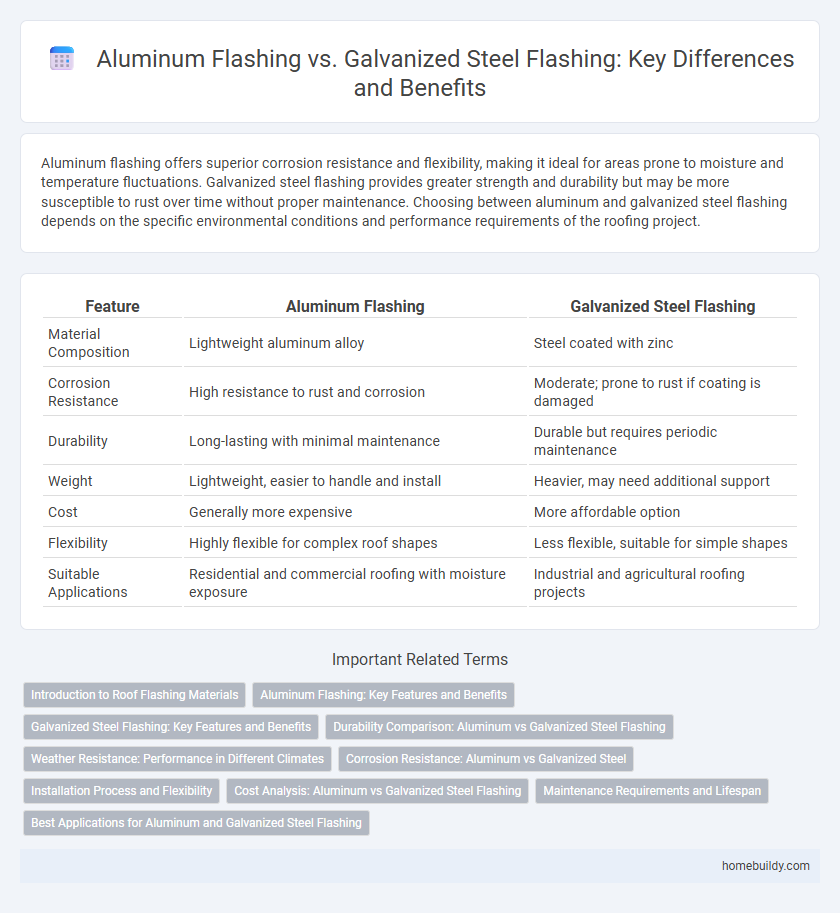Aluminum flashing offers superior corrosion resistance and flexibility, making it ideal for areas prone to moisture and temperature fluctuations. Galvanized steel flashing provides greater strength and durability but may be more susceptible to rust over time without proper maintenance. Choosing between aluminum and galvanized steel flashing depends on the specific environmental conditions and performance requirements of the roofing project.
Table of Comparison
| Feature | Aluminum Flashing | Galvanized Steel Flashing |
|---|---|---|
| Material Composition | Lightweight aluminum alloy | Steel coated with zinc |
| Corrosion Resistance | High resistance to rust and corrosion | Moderate; prone to rust if coating is damaged |
| Durability | Long-lasting with minimal maintenance | Durable but requires periodic maintenance |
| Weight | Lightweight, easier to handle and install | Heavier, may need additional support |
| Cost | Generally more expensive | More affordable option |
| Flexibility | Highly flexible for complex roof shapes | Less flexible, suitable for simple shapes |
| Suitable Applications | Residential and commercial roofing with moisture exposure | Industrial and agricultural roofing projects |
Introduction to Roof Flashing Materials
Aluminum flashing offers superior corrosion resistance and lightweight properties, making it ideal for environments prone to moisture and rust. Galvanized steel flashing provides enhanced strength and durability due to its zinc coating, which helps prevent rust but may require more maintenance over time. Choosing between aluminum and galvanized steel depends on factors such as climate, durability needs, and budget constraints.
Aluminum Flashing: Key Features and Benefits
Aluminum flashing offers excellent corrosion resistance, making it ideal for roofing applications exposed to moisture and harsh weather conditions. Lightweight yet durable, aluminum flashing is easy to install and requires minimal maintenance, providing long-lasting protection for roof edges, chimneys, and vents. Its flexibility allows for seamless integration with various roofing materials, enhancing overall waterproofing and preventing leaks.
Galvanized Steel Flashing: Key Features and Benefits
Galvanized steel flashing offers robust corrosion resistance due to its protective zinc coating, making it ideal for long-lasting roof protection. Its high tensile strength ensures durability against severe weather conditions and mechanical damage. This material is also cost-effective and readily available, providing an efficient solution for waterproofing joints and preventing leaks in roofing systems.
Durability Comparison: Aluminum vs Galvanized Steel Flashing
Aluminum flashing offers superior resistance to corrosion and rust, making it more durable in moist environments compared to galvanized steel flashing, which can degrade over time when exposed to sustained moisture. Galvanized steel flashing provides greater strength and impact resistance, but its protective zinc coating may wear off, requiring maintenance or replacement. Choosing aluminum flashing ensures longer-lasting performance in coastal or high-humidity areas, while galvanized steel suits applications demanding higher structural durability.
Weather Resistance: Performance in Different Climates
Aluminum flashing offers superior corrosion resistance, making it ideal for coastal or high-humidity environments where salt and moisture exposure is frequent. Galvanized steel flashing provides increased strength and durability, performing well in harsher climates with heavy snow or strong winds but may require additional maintenance to prevent rust over time. Both materials excel in weather resistance when installed properly, yet aluminum's natural oxidation layer ensures longer-lasting protection against rain and UV exposure.
Corrosion Resistance: Aluminum vs Galvanized Steel
Aluminum flashing offers superior corrosion resistance due to its natural oxide layer, which prevents rust and degradation in moist environments. Galvanized steel flashing relies on a zinc coating that can wear away over time, leading to potential rust formation and reduced durability. For long-term protection against weather elements, aluminum flashing is often preferred in roofing applications where corrosion resistance is critical.
Installation Process and Flexibility
Aluminum flashing offers greater flexibility and is easier to mold around complex roof shapes compared to galvanized steel flashing, which is more rigid and challenging to bend during installation. The lighter weight of aluminum simplifies handling and fastening, reducing labor time and effort, whereas galvanized steel requires more precise cutting and securing tools due to its stiffness and durability. Both materials resist corrosion, but aluminum's adaptability makes it preferable for custom or intricate flashing applications where ease of fitting and shaping is crucial.
Cost Analysis: Aluminum vs Galvanized Steel Flashing
Aluminum flashing generally costs more upfront than galvanized steel but offers superior corrosion resistance and longevity, reducing long-term maintenance expenses. Galvanized steel flashing is more affordable initially but may require frequent replacements or repairs due to rust and weather degradation. Evaluating total lifecycle costs, aluminum flashing often proves more cost-effective despite higher initial investment.
Maintenance Requirements and Lifespan
Aluminum flashing requires less maintenance due to its natural corrosion resistance, often lasting 20 to 30 years without significant deterioration. Galvanized steel flashing demands more frequent inspections and upkeep, such as rust prevention treatments, with an average lifespan of 15 to 20 years. Choosing aluminum can reduce long-term maintenance costs and extend the overall durability of roof flashing systems.
Best Applications for Aluminum and Galvanized Steel Flashing
Aluminum flashing is ideal for coastal and metal roofs due to its corrosion resistance and lightweight properties, making it suitable for harsh weather conditions and easy installation. Galvanized steel flashing offers superior strength and durability, making it a better choice for industrial buildings and areas with high mechanical stress or impact risks. Both materials require proper maintenance to maximize lifespan, but aluminum excels in rust-prone environments while galvanized steel provides enhanced structural support.
aluminum flashing vs galvanized steel flashing Infographic

 homebuildy.com
homebuildy.com